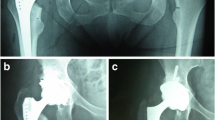Abstract
Background
Safe surgical dislocation of the hip is a versatile approach to the hip joint with a low complication rate. Hip joint instability is a devastating complication with poor prognosis.
Methods
All hips treated surgically through the safe surgical dislocation approach were entered in a database and the complication of hip joint instability was studied prospectively from 2000 to 2021. Instability was diagnosed by intraoperative stress examination and on postoperative radiographs. The initial deformities treated, type of instability, presumed causes, treatment provided, response to the treatment, and final result were recorded as they happened during the course of the treatment. We considered patient’s age, sex, body mass index (BMI), and initial diagnosis as risk factors. We evaluated the radiographs for femoral neck shortening, lack of greater trochanteric advancement, acetabular deformity, and incongruity of the hip joint. Anterior hip precautions were initiated in the middle of the study period.
Results
22/459 hips developed hip joint instability after surgical dislocation approach performed for hip preservation. Acetabular deficiency, coxa breva, coxa valga, posterior impingement, increased anteversion, lax soft tissues, medial thigh obesity and lack of postoperative precautions seemed to contribute to instability. 50% of the hips became normal. Chondrolysis and residual subluxation were common in the others.
Conclusion
Surgical dislocation approach disrupts the soft tissue restraints of the hip and joint stability depends on bony morphology, abductor muscle tension, and postoperative precautions. Several risk factors were subjective and speculative, but awareness of all the potential risk factors and prevention and treatment options should decrease this complication.
Level of Evidence
IV Case series.


Similar content being viewed by others
References
Ganz, R., Gill, T. J., Gautier, E., Ganz, K., Krügel, N., & Berlemann, U. (2001). Surgical dislocation of the adult hip A technique with full access to the femoral head and acetabulum without the risk of avascular necrosis. The Journal of Bone and Joint Surgery. https://doi.org/10.1302/0301-620X.83B8.0831119
Sink EL, Beaulé PE, Sucato D, Kim YJ, Millis MB, Dayton M, Trousdale RT, Sierra RJ, Zaltz I, Schoenecker P, Monreal A, Clohisy J. Multicenter study of complications following surgical dislocation of the hip. J Bone Joint Surg Am. 2011 Jun 15;93(12):1132-6. doi: 10.2106/JBJS.J.00794. PMID: 21571987.
Leunig, M., Slongo, T., & Ganz, R. (2008). Subcapital realignment in slipped capital femoral epiphysis: Surgical hip dislocation and trimming of the stable trochanter to protect the perfusion of the epiphysis. Instructional Course Lectures, 57, 499–507.
Ganz, R., Aprato, A., Mazziotta, G., & Pignatti, G. (2016). Joint instability after anatomic reconstruction of severe, chronic slipped capital femoral epiphysis: a report of 3 cases, with high femoral anteversion in 1 and adaptive acetabular roof deformation in 3. JBJS Case Connect., 6(2), e50.
Leunig, M., Manner, H. M., Turchetto, L., & Ganz, R. (2017). Femoral and acetabular re-alignment in slipped capital femoral epiphysis. Journal of Children’s Orthopaedics, 11(2), 131–137.
Upasani, V. V., Matheney, T. H., Spencer, S. A., Kim, Y. J., Millis, M. B., & Kasser, J. R. (2014). Complications after modified Dunn osteotomy for the treatment of adolescent slipped capital femoral epiphysis. Journal of Pediatric Orthopedics, 34(7), 661–667.
Aprato, A., Leunig, M., Massé, A., Slongo, T., & Ganz, R. (2017). Instability of the hip after anatomical re-alignment in patients with a slipped capital femoral epiphysis. Bone Joint Journal, 99(1), 16–21.
Upasani, V. V., Birke, O., Klingele, K. E., & Millis, M. B. (2017). International SCFE study group iatrogenic hip instability is a devastating complication after the modified dunn procedure for severe slipped capital femoral epiphysis. Clinical Orthopedics Related Research, 475(4), 1229–1235.
Graham, B., & Lapp, R. A. (1990). Recurrent posttraumatic dislocation of the hip. A report of two cases and review of the literature. Clinical Orthopedics Related Research, 256, 115–119.
Trousdale, R. T. (2003). Recurrent anterior hip instability after a simple hip dislocation: A case report. Clinical Orthopaedics and Related Research, 408, 189–192.
Carlson, B. C., Desy, N. M., Johnson, J. D., Trousdale, R. T., Leunig, M., Ganz, R., & Sierra, R. J. (2018). Modern surgical treatment of recurrent posterior dislocation of the native hip. Journal of Bone and Joint Surgery. American Volume, 100(12), 1056–1063.
Author information
Authors and Affiliations
Corresponding author
Ethics declarations
Conflict of Interest
On behalf of all authors, the corresponding author states that there is no conflict of interest.
Additional information
Publisher's Note
Springer Nature remains neutral with regard to jurisdictional claims in published maps and institutional affiliations.
Rights and permissions
Springer Nature or its licensor (e.g. a society or other partner) holds exclusive rights to this article under a publishing agreement with the author(s) or other rightsholder(s); author self-archiving of the accepted manuscript version of this article is solely governed by the terms of such publishing agreement and applicable law.
About this article
Cite this article
Gourineni, P., Valleri, D., Mungalpara, N. et al. Hip Joint Instability After Surgery Performed Through the Surgical Dislocation Approach. JOIO 57, 762–767 (2023). https://doi.org/10.1007/s43465-023-00844-3
Received:
Accepted:
Published:
Issue Date:
DOI: https://doi.org/10.1007/s43465-023-00844-3




